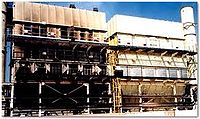Difference between revisions of "Explosion Panels"
(Created page with "Category:Explosion Safety{{Knoppen}} <noinclude><!------------------------------------------------ * READ THIS FIRST * Only edit this page if you can improve the content. * ...") |
PurplePen19 (talk | contribs) |
||
| Line 7: | Line 7: | ||
* Please start editing this page after the /noinclude | * Please start editing this page after the /noinclude | ||
* -------------------------------------------------></noinclude> | * -------------------------------------------------></noinclude> | ||
[[File:Explosion Panel_1.jpg|thumb|200px|right|Explosion Panel]] | |||
An '''Explosion Panel''' is a device designed to protect industrial process equipment against the damaging effects of dust and gas explosions. | |||
Explosion pressure relief, commonly referred to as venting, is probably the most widely practised and best understood protective measure used to control the effects of an industrial explosion. Explosion venting is intended to prevent the destruction of an enclosure due to any other overpressure condition caused by an explosion. | |||
It may also prevent the enclosure from rupturing due to any other overpressure caused by mechanical system failure or even against the effects of vacuum pressures in the system. | |||
Due to its passive nature explosion venting is often the preferred method for protecting enclosures from the potential overpressures generated by combustion. | |||
==Video== | |||
<youtube>5MjcQHUnhqI</youtube> | |||
Latest revision as of 06:10, 22 October 2012
An Explosion Panel is a device designed to protect industrial process equipment against the damaging effects of dust and gas explosions.
Explosion pressure relief, commonly referred to as venting, is probably the most widely practised and best understood protective measure used to control the effects of an industrial explosion. Explosion venting is intended to prevent the destruction of an enclosure due to any other overpressure condition caused by an explosion.
It may also prevent the enclosure from rupturing due to any other overpressure caused by mechanical system failure or even against the effects of vacuum pressures in the system.
Due to its passive nature explosion venting is often the preferred method for protecting enclosures from the potential overpressures generated by combustion.
Video
